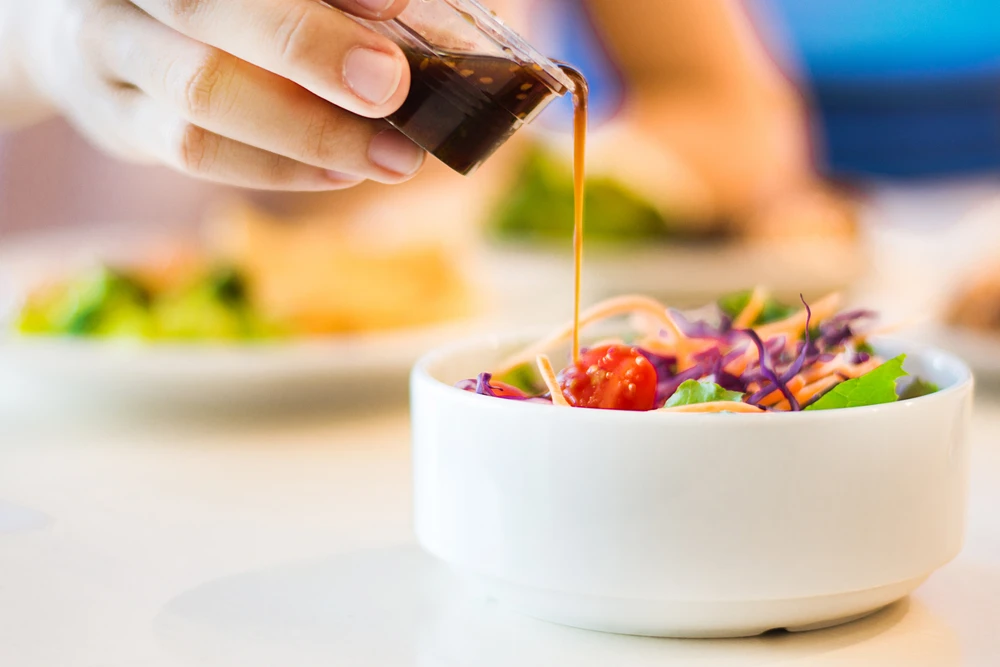Among the many sauces that define French cuisine, none is simpler or more essential than vinaigrette. Made with just a few ingredients, it embodies the art of balance — a perfect mix of acidity, richness, and flavor. Whether for a green salad, grilled vegetables, or lentils, the French vinaigrette is a small act of everyday gastronomy.
The authentic French vinaigrette recipe
The classic proportion is easy to remember:
- 1 tablespoon of vinegar for 3 tablespoons of oil,
- 1 teaspoon of mustard, a pinch of salt, and a little pepper.
Whisk the mustard, vinegar, and salt together first to make a smooth base. Then, pour the oil slowly while whisking until the sauce thickens slightly — that’s the emulsion.
💡 Chef’s tip: Use an empty jam jar! Add everything, close the lid, shake hard — and voilà, it’s ready.
Variations loved in France
The beauty of the vinaigrette is that every French region has its own version.
Here are some easy ways to vary your dressing:
Choose your oil
-
Olive oil: fruity and Mediterranean.
-
Walnut oil: rustic, perfect for endives or blue cheese.
-
Hazelnut oil: delicate and elegant.
-
Sunflower oil: light and neutral, ideal for summer salads.
Choose your vinegar
-
Red wine vinegar: the most traditional.
-
Apple cider vinegar: mild and fruity.
-
Balsamic vinegar: richer and slightly sweet.
-
Or replace it with fresh lemon juice for a lighter touch.
Flavor ideas straight from French kitchens
-
Shallot vinaigrette: chop a small shallot for extra sharpness.
-
Honey vinaigrette: sweet and soft, ideal with goat cheese salad.
-
Old-style mustard vinaigrette: adds texture and bold flavor.
-
Herb vinaigrette: with chives, parsley, or tarragon, depending on the season.
Each combination lets you create your own version — just like the man who invented it more than two centuries ago.
Who invented the vinaigrette?
A meal in the time of the Chevalier d'Albignac / Photo selected by Monsieur de France: By Jean-François de Troy — Harry Brejat / RMN, Public domain, https://commons.wikimedia.org/w/index.php?curid=6635722
When a poor French nobleman became a culinary star
In the 18th century, a penniless French nobleman named Chevalier d’Albignac was living in London. France was already famous for its gastronomy, and at a dinner party one evening, he was asked to dress the salad. Inspired, he mixed oil, vinegar, and a little mustard — a simple idea that charmed the guests. Soon, all of London wanted to taste this new “French sauce.” The Chevalier started offering his dressing professionally, carrying a small chest filled with different oils, vinegars, and mustards. He became rich, returned to France, and bought a château in the Limousin region. And that’s how the French vinaigrette was born — the perfect blend of French creativity and elegance.
FAQ – All about French vinaigrette
What is the classic ratio for French vinaigrette?
One part vinegar for three parts oil — it’s the golden rule. Adjust to your taste for more acidity or smoothness.
Can I make vinaigrette without mustard?
Yes, but mustard helps the sauce emulsify. Without it, shake well before serving.
What oil is best for vinaigrette?
Olive oil for fruitiness, walnut oil for richness, or a neutral oil like sunflower for a lighter touch.
Can I make it ahead?
Absolutely. Store in a small jar and refrigerate up to 4 days. Shake before each use.
Where does vinaigrette come from?
It was invented in the 18th century by Chevalier d’Albignac, a French nobleman living in London.
<time datetime="2025-11-10">Updated: November 2025</time>





